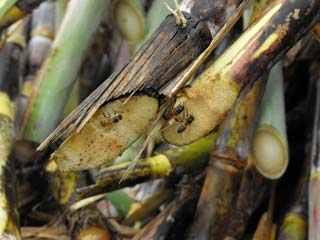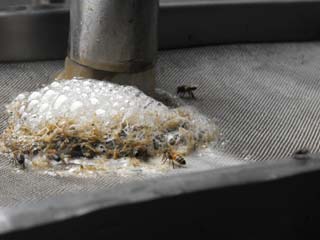Muddling Herb Cane.

Fresh-cut sugar cane.

Bees in fresh-pressed cane juice.
Duggan McDonnell is a culinary boozehound, an educator, consultant, and a partner in the Latin cocktail lounge, Cantina.
Raising Cane!
Portuguese can be tough on the tongue. Like the word cachaça (kuh-shaw-suh), for instance. When sloppily said, the word might sound as if it came from a fat kid slurring through a mouth full of Snickers. Another tough one, caipirinha (ky-purr-rean-yuh), makes for an interesting dichotomy: one of the more increasingly popular cocktails in the States is also one of the most difficult to pronounce. I know; in the two years since we opened Cantina and after muddling nearly 50,000 caipirinhas, the staff feels as though they've been teaching 'Portuguese for Dummies.' (At least through the guise of Brazilian booze.) And this coming Friday for International Cachaça Day, I'm certain time spent on language lessons and cocktail muddling will respectably increase.
Cachaça is Brazil's national spirit and the second most-oft distilled spirit in the world. Its chief vehicle also belongs to Brazil in the form of its national cocktail, the quarto-syllabic caipirinha. The caipirinha is a damn fine cocktail, delicious and refreshing. At Cantina, we sling a California-esque riff on the traditional recipe which Food & Wine recently published in their Cocktails '09 guide, while 7x7 features another of my riffs, the Mango & Cardamom Caipirinha, as their Drink of the Month.
When we opened Cantina, just over two years ago, our shelves held the largest collection of cachaça stateside. Why? Because it could be done. With over 28 different bottlings, a flight of cachaça at Cantina was a daunting endeavor. And it's this sort of silly, albeit improbable, task that excited me. I've long loved culture South of the Border; I've loved those countries born of being conquered by the greedy men from Romance countries; I've loved the story of survival and the indigenous, new spirits that South and Central America have shared with the world; and still, I love the taste of heat, the jungle, and the vine present in these spirits.
This past winter I had the opportunity to visit Brazil, to taste and touch cane, and to see an old alembic pot still. If you like good booze, then you'll agree with me: pot stills are a thing of beauty. And in my opinion, one should only drink good booze. Lucky for us there are several delicious pot-distilled cachaças in the States.
To the question, "What is cachaça?," I most often answer, "Brazilian rum," because that is what the U.S. government decreed was the proper label for American consumers. But it isn't, really. Cachaça is more, er, different than rum. Where rum is traditionally distilled from a molasses often sourced from outside the producer's own country, the best cachaças are not only from Brazil, but estate-produced, with sugar cane grown and hand-cut, pressed into a fermentable 'wine' and then distilled. It's a longer, closer-to-the-earth process, resulting in more terroir-driven flavors: olives, lemon verbena, young vanilla, and oily cinnamon.
To be in Brazil, where it's muggy yet so, so beautiful, to touch cane, and to see an old alembic still and to know its history, was as amazing for me as standing atop of Spring Mountain and eyeing all the Napa Valley's vineyards below.
This Friday June 12th, remembers June 12, 1744, when Portugal banned the production of cachaça in their then colony, Brazil. Of course, the Brazilians didn't stop and today they have a rich cultural and cocktail history because of their resilience. It's just this type of spirit that we in the Barbary Coast should celebrate. Joining me in this celebration will be some of my favorite restaurants and bars in San Francisco slinging signature cachaça cocktails of their own. Some folks are already planning a Cachaça Cocktail Crawl. How fun will it be to slur a little Portuguese after a night spent swilling San Francisco's best cocktails?
As for the cocktail I will be making on Friday, it will be a uniquely San Franciscan-Brazilian hybrid: the Herb Cane.
4 basil leaves and 4 leaves of mint
2 oz. Cachaça
.5 oz. Chartreuse (Green)
.5 oz. Sugar Syrup
1 oz. Fresh-squeezed Lemon Juice
Muddle the herbs, pour the liquids, then shake vigorously, and double-strain the liquid into an empty rocks glass. Garnish with a long orange peel squeezed and dropped into the cocktail.
At Cantina, and around San Francisco, talented barfolk have given homes to cachaça in many new cocktail ways beyond the tried-and-true caipirinha. I find this exactly as it should be. Cachaça bears its history of ingenuity and resilience, and San Francisco upholds its culture of culinary innovation. If only our linguistic skills matched those of our palates, our tongues could speak better to cachaça's delicious possibilities.
Saudé!



